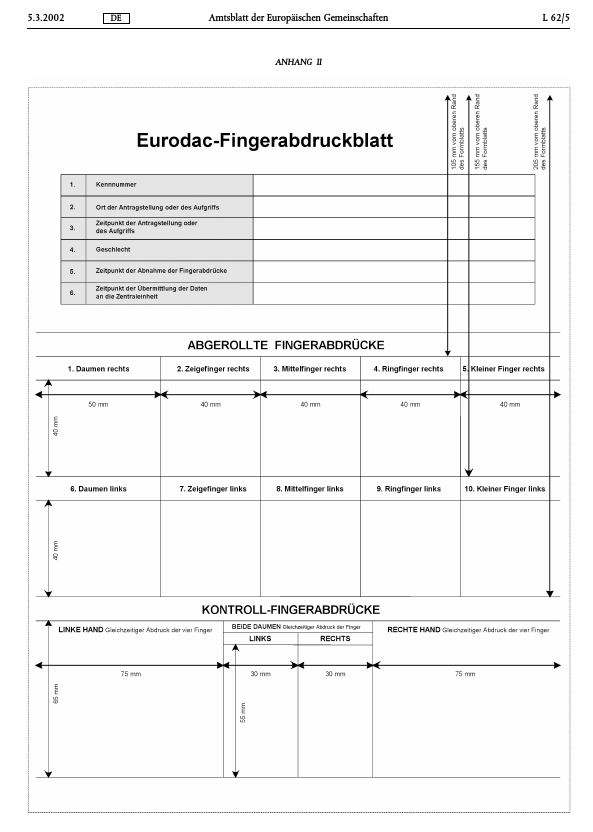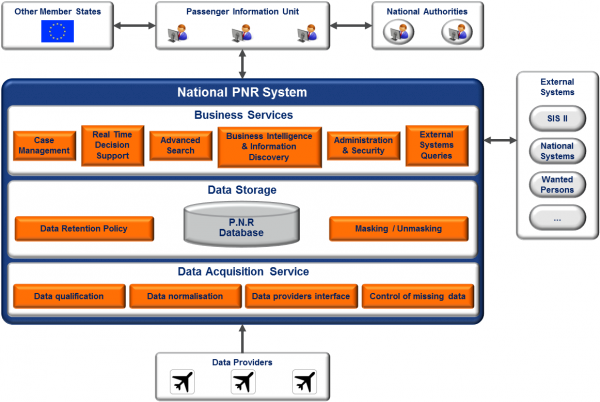Eurodac Implementierung (BD2015): Unterschied zwischen den Versionen
Anna (Diskussion | Beiträge) K (→Eurodac Formular: content) |
Anna (Diskussion | Beiträge) K (Hustinx) |
||
| Zeile 106: | Zeile 106: | ||
[[Bild:Stpnr.png|600px]] | [[Bild:Stpnr.png|600px]] | ||
</p> | </p> | ||
| + | |||
| + | <br /> | ||
| + | |||
| + | ===[https://secure.edps.europa.eu/EDPSWEB/webdav/shared/Documents/Consultation/Opinions/2012/12-09-05_EURODAC_EN.pdf Peter Hustinx: Stellungnahme zur Erweiterung der Eurodac Zugriffs]=== | ||
| + | |||
| + | 3. ACCESS TO EURODAC DATA FOR LAW ENFORCEMENT PURPOSES | ||
| + | |||
| + | 3.1. Purpose limitation and the risk of function creep | ||
| + | |||
| + | 25. When the Regulation establishing EURODAC was adopted and the database became operational in 2003, it did not contemplate police access to its database. The fingerprints are collected and processed for purposes of determining which Member State is responsible for examining an asylum application, for preventing multiple asylum applications within the EU and, more in general, for facilitating the application of the Dublin Regulation. 31 Specific safeguards are provided to ensure that the EURODAC database is not used for other purposes. | ||
| + | |||
| + | 26. The Proposal suggests a new legal regime, in which data will still be collected for the purpose of examining asylum applications, but the data could - under certain circumstances - be used for another purpose, i.e. law enforcement outside the context of asylum and migration. This constitutes what is often described as "function creep", namely, a gradual widening of the use of a system or database | ||
| + | beyond the purpose for which it was originally intended. | ||
| + | |||
| + | 27. In general, the EDPS has strong reservations against this trend. He calls for a cautious approach as to initiatives with a view to possible use of data or systems for other unrelated purposes. It should not be easily accepted that since the data is already collected, it can just as well be used for other purposes which might have a bigger impact on the life of individuals. The assessment as to the | ||
| + | necessity and proportionality of the creation of EURODAC would have been completely different if law enforcement access was envisaged from the outset. | ||
<br /> | <br /> | ||
Version vom 5. November 2015, 14:18 Uhr
Inhaltsverzeichnis
- 1 Eurodac Formular
- 2 The Cogent Systems/Steria European Commission's EURODAC Automated Fingerprint Identification System
- 3 Steria Pressekommunique Eurodac
- 4 Steria "Advanced Passenger Information" und "Passenger Name Record"
- 5 Peter Hustinx: Stellungnahme zur Erweiterung der Eurodac Zugriffs
- 6 EU-LISA Tätigkeitsbericht 2014
Eurodac Formular
Eurodac Verordnung des Europäischen Parlaments 2013
| Kennung | Ort | Zeitpunkt Antrag | Geschlecht | Zeitpunkt Eintrag | Zeitpunkt forward | Fingerabdrücke |
|---|---|---|---|---|---|---|
| 456 | Gmünd | 12.12.2121 | ja | 12.12.2121 | 13.21.2121 | 
|
| 470 | Mars | 23.9.1887 | nein | 23.9.1887 | 21.9.1887 | 
|
Identifizierung
Eurodac Verordnung, Präambel (4) - (6)
(4)
Die Anwendung der Verordnung ... zur Festlegung der Kriterien und Verfahren zur Bestimmung des Mitgliedstaats, der für die Prüfung eines von einem Drittstaatsangehörigen oder Staatenlosen in einem Mitgliedstaat gestellten Antrags auf internationalen Schutz zuständig ist (5), setzt voraus, dass die Identität der Personen, die internationalen Schutz beantragen, und der Personen, die beim illegalen Überschreiten der Außengrenzen der Union aufgegriffen wurden, festgestellt wird. Im Sinne einer wirksamen Anwendung ... wäre es darüber hinaus wünschenswert, dass jeder Mitgliedstaat in Erfahrung bringen kann, ob ein Drittstaatsangehöriger oder Staatenloser, der sich illegal in seinem Hoheitsgebiet aufhält, bereits in einem anderen Mitgliedstaat einen Antrag auf internationalen Schutz gestellt hat.
(5)
Fingerabdrücke sind ein wichtiges Mittel zur genauen Identifizierung dieser Personen. Es bedarf eines Systems zum Vergleich der Fingerabdruckdaten.
(6)
Hierzu ist es notwendig, ein europaweites FingerabdruckIdentifizierungssystem mit der Bezeichnung "Eurodac" einzurichten, das aus einem Zentralsystem, das als eine automatisierte Zentraldatenbank für Fingerabdruckdaten betrieben wird, und elektronischen Einrichtungen für die Datenübertragung zwischen den Mitgliedstaaten und dem Zentralsystem (im Folgenden "Kommunikationsinfrastruktur") besteht.
The Cogent Systems/Steria European Commission's EURODAC Automated Fingerprint Identification System
The EURODAC Automated Fingerprint Identification System (AFIS) system will enable Member States of the European Union (plus Norway and Iceland) to identify asylum-seekers and persons who have crossed an external frontier of the European Union in an irregular manner and has been implemented to effectively apply the regulations defined in Dublin Convention. By comparing fingerprints Member States can determine whether an asylum-seeker or a foreign national found illegally in one Member State has previously claimed asylum in another Member State.
The Cogent and teaming partner Steria supplied EURODAC system utilizes a Cogent Systems computerized central database for comparing the fingerprints of asylum applicants and a Steria system for electronic data transmission between Member States and the database.
The central Cogent System utilizes its advanced biometric matching algorithms technology and proprietary Programmable Matching Accelerator (PMA) matching engines to drive the central computer database. This Cogent system is the fastest, most accurate off-the-shelf fingerprint-matching device in the world. Designed for use as the central fingerprint search/match processor(s) of a distributed network of fingerprint submission workstations, each PMA in a system can be configured to provide matching rates of up to 500,000 matches per second.
...
EURODAC Member States can now transmit tenprint records to the Cogent central system from asylum applicants and from alien people who may have irregularly crossed borders or who may be staying illegally in any of the EU signatory countries.
About Cogent Systems
Cogent Systems. Inc. based in South Pasadena, California, is a world-leading supplier of integrated system solutions using biometrics for law enforcement, government and commercial customers.
Cogent is the only provider of biometric identification systems that can accurately perform biometric comparisons using its Image Flow (patent pending) matching algorithm technology and its massively parallel processing Data Flow (patent pending) supercomputing technology to provide high performance real-time identification and authentication for information systems. For over 10 years, Cogent's core technologies have been proven effective in supporting identification needs for international law enforcement, government and civil agencies.
Steria Pressekommunique Eurodac
14 janvier 2003
La Commission européenne retient le savoir-faire de Steria en biométrie pour traiter les demandes d'asile et lutter contre l'immigration clandestine.
A l'heure de la fermeture du centre de réfugiés de Sangatte (Link anna), les questions de l'immigration en Europe sont plus que jamais d'actualité. La Commission européenne a inauguré le projet EURODAC aujourd'hui à 12 heures GMT (13h à Paris). Ce projet vise à traiter les demandes d'asile dans les états membres de l'Union européenne et dans d'autres états signataires de la convention de Dublin. Dans le cadre de ce projet, Steria, opérateur global de services informatiques en Europe, a mis au point d'une part, le système central d'identification des empreintes digitales (basé à Bruxelles), et d'autre part, dans 16 pays européens, le système de transmission électronique des empreintes digitales permettant de lutter contre l'immigration clandestine.
Le système EURODAC permet aux états membres d'identifier les demandeurs d'asile ainsi que les personnes ayant franchi irrégulièrement une frontière extérieure de la Communauté. En comparant les empreintes, ces états peuvent vérifier si un demandeur d'asile ou un ressortissant étranger se trouvant illégalement sur son territoire a déjà formulé une demande dans un autre état de l'Union européenne.
Steria "Advanced Passenger Information" und "Passenger Name Record"
Peter Hustinx: Stellungnahme zur Erweiterung der Eurodac Zugriffs
3. ACCESS TO EURODAC DATA FOR LAW ENFORCEMENT PURPOSES
3.1. Purpose limitation and the risk of function creep
25. When the Regulation establishing EURODAC was adopted and the database became operational in 2003, it did not contemplate police access to its database. The fingerprints are collected and processed for purposes of determining which Member State is responsible for examining an asylum application, for preventing multiple asylum applications within the EU and, more in general, for facilitating the application of the Dublin Regulation. 31 Specific safeguards are provided to ensure that the EURODAC database is not used for other purposes.
26. The Proposal suggests a new legal regime, in which data will still be collected for the purpose of examining asylum applications, but the data could - under certain circumstances - be used for another purpose, i.e. law enforcement outside the context of asylum and migration. This constitutes what is often described as "function creep", namely, a gradual widening of the use of a system or database beyond the purpose for which it was originally intended.
27. In general, the EDPS has strong reservations against this trend. He calls for a cautious approach as to initiatives with a view to possible use of data or systems for other unrelated purposes. It should not be easily accepted that since the data is already collected, it can just as well be used for other purposes which might have a bigger impact on the life of individuals. The assessment as to the necessity and proportionality of the creation of EURODAC would have been completely different if law enforcement access was envisaged from the outset.
EU-LISA Tätigkeitsbericht 2014
Die Planung wurde fortgeführt, um die funktionalen Veränderungen nach Annahme der Neufassung der Eurodac-Verordnung5 am 26. Juni 2013 durchzuführen (ab 20. Juli 2015 anzuwenden). Die wichtigste aufgrund der Neufassung durchzuführende entwicklungstechnische Änderung (um eine Abfrage der vorhandenen Daten zu Strafverfolgungszwecken in begrenztem Umfang zu gestatten) macht umfassende Modifikationen an operativen und technischen Aspekten der Funktionalität des Eurodac-Systems erforderlich. Während des Berichtszeitraums wurde damit begonnen, die Infrastruktur und Ressourcen einzurichten, um die in der Neufassung der Verordnung vorgesehenen Änderungen in der vorgesehenen Zeit zu implementieren. Ferner wurden die entsprechenden Projektteams und Governance-Strukturen eingerichtet und sind jetzt betriebsbereit.

